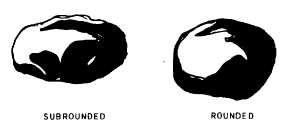PHYSICAL CHARACTERISTICS
OF SOILS
The physical characteristics of soils aid in
determining their engineering characteristics and
are the basis of the system of soil classification
used in the SEABEEs and by the military in
general for the identification of soil types. A
knowledge of these physical characteristics aids
in determining the degree to which local soils can
be used in engineering projects to support traffic
loads or to serve as a subgrade or foundation
material. Those characteristics of concern to the
EA are discussed below.
PARTICLE SIZE
Soils are divided into groups based on the size
of the particle grains in the soil mass. The EA
identifies the sizes through the use of sieves. A
sieve is a screen attached across the end of a
shallow cylindrical frame. The screen permits par-
ticles smaller than the openings to fall through
and larger ones to be retained on the sieve. When
sieves of different sizes are stacked so that the
largest screen openings are at the top and the
smallest at the bottom, soil can be separated into
particle groups based on size. The amount remain-
ing on each sieve is measured and described as
a percentage by weight of the entire sample. Table
15-1 shows size groups as used in the Unified Soil
Classification System. Particles passing the No.
200 sieve but larger than 0.002 mm to 0.005 mm
are called silt, and those finer are clays.
PARTICLE SHAPE
The shape of the particles influences the
strength and stability of a soil. Two general shapes
are normally recognized: BULKY (fig. 15- 1) and
PLATY.
Bulky
Cobbles, gravel, sand, and silt particles cover
a large range of sizes; however, they are all bulky
in shape. The term bulky is confined to particles
that are relatively large in all three dimensions,
as contrasted to platy particles, in which one
dimension is small as compared to the other two.
The bulky shape has the following four subdivi-
sions listed in descending order of desirability for
construction:
ANGULAR particles are those that have been
recently broken up and are characterized by
jagged projections, sharp ridges, and flat surfaces.
Angular gravels and sands are generally the best
materials for construction because of their in-
terlocking characteristics. Such particles are
seldom found in nature, however, because the
weathering process does not generally produce
them. Angular material must usually be produced
artificially, by crushing.
SUBANGULAR particles are those that have
been weathered to the extent that the sharper
points and ridges have been worn off.
SUBROUNDED particles are those that
have been weathered to a further degree
than subangular particles. They are still some-
what irregular in shape but have no sharp
corners and few flat areas. Materials with this
shape are frequently found in stream beds. If
composed of hard, durable particles, subrounded
material is adequate for most construction
needs.
ROUNDED particles are those on which all
projections have been removed, with few
irregularities in shape remaining. The particles
resemble spheres and are of varying sizes.
Rounded particles are usually found in or near
stream beds or beaches.
Platy
Platy (or flaky) particles are those that have
flat, platelike grains. Clay is a common example.
Because of their shape, these flaky particles have
a greater contact area for moisture and are un-
desirable for construction purposes.
Figure 15-1.-Types of bulky-shaped soil particles (grains).
15-3




